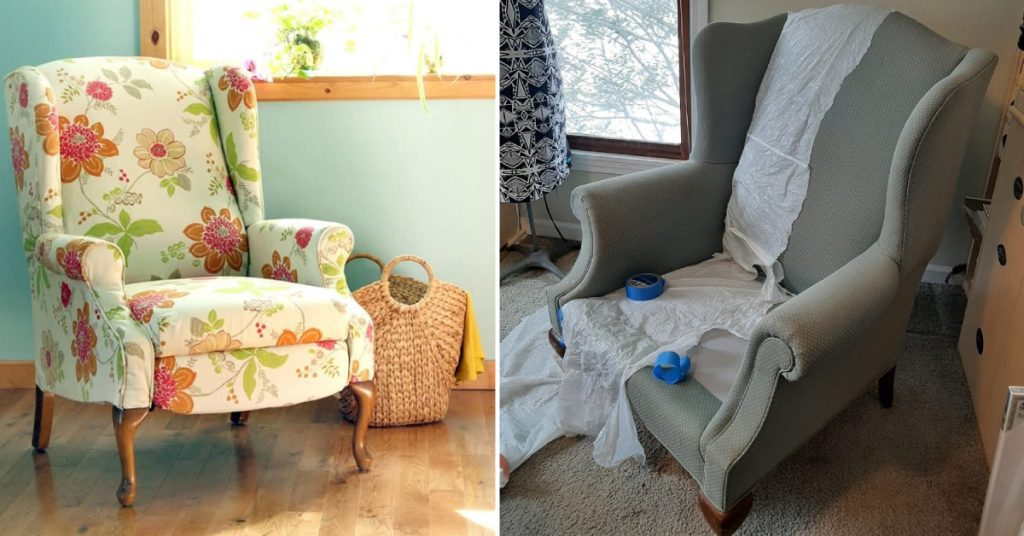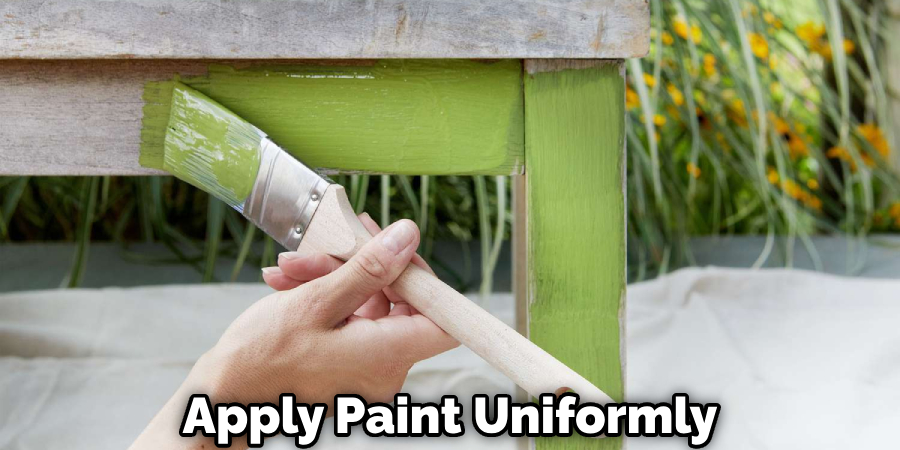Transforming your dated or dull fabric chair into a fresh and modern piece of furniture can be an exhilarating DIY project. Not only does it give a personal touch to your home decor, but it’s also a great way to upcycle and contribute to sustainability. Whether you’re a craft enthusiast or a first-time painter, learn how to paint fabric chair with this detailed guide.

Key Takeaways:
- Assess fabric condition and type before painting
- Use chalk paint or latex/acrylic paint with fabric medium
- Thoroughly prepare the surface; apply primer
- Paint in smooth, even strokes; let dry fully between coats
- Seal-painted fabric to protect the finish
- Add personal touches like throw pillows to complement
- Clean gently with mild detergent to maintain the revamped chair
7 Easy Step-by-Step Guide for How to Paint Fabric Chair
Here are the steps to follow on how to paint fabric chair:
Step 1: Assess if Your Fabric Chair is Suitable for Painting
Before you get started painting, it’s important to assess whether your chair is a good candidate for a paint makeover. The type of fabrics can greatly affect the outcome. In general, chairs with tight-weave fabric like cotton or polyester should take paint well. However, overly worn or loose-weave fabrics may not hold paint as effectively. Ensure that the upholstered furniture is in decent condition to avoid unnecessary effort on a piece that might need more than just a cosmetic update.
Step 2: Choose the Right Paint and Supplies
Choosing the correct type of paint is pivotal in ensuring not only a great finish but also the durability of your chair. Chalk paint and latex paints are popular choices for painting upholstery due to their thick consistency and coverage capability. Additionally, consider using a fabric medium to mix with acrylic paints to enhance flexibility and prevent the fabric from stiffening.
Regarding supplies, high-quality brushes or a spray bottle for water can help you apply the paint in circular motions for an even coat. A spray bottle can also keep the fabric moist, which allows the paint to spread more easily.
Step 3: Prepare the Chair for Painting
Preparation is key to the painting process. Start with a completely dry, clean surface, and if the chair has removable cushions, take them out to paint separately. Lightly sand/rough up the fabric to prepare it for better paint adherence and consider applying a thin coat of primer specifically designed for fabric to ensure your base coat of paint has a solid foundation.
Step 4: Apply the Base Coat of Paint
The base coat is crucial as it sets the stage for how the rest of the painting job will go. Use consistent, smooth brush strokes or a sponge to apply paint uniformly across the surface of the fabric. The goal here is to achieve good coverage so that you do not require too many coats afterward. Allow this layer to dry fully — patience is important.

Step 5: Add Additional Paint Coats as Needed
Depending on the original color of your fabric, you might need additional coats—especially if you are painting over a light colored fabric with a darker paint. Apply subsequent coats of paint with the same careful technique as the base layer, allowing each layer to completely dry before the next application. If the fabric feels stiff, lightly sand it with fine-grit sandpaper between coats.
Step 6: Seal and Protect the Painted Fabric
After the final coat has dried, consider applying a sealant or top coat made of fabric to protect your work and ensure the longevity of the paint. This will help resist dirt and stains on your newly painted fabric furniture and give it an extra layer of durability.
Step 7: Re-assemble the Chair and Style as Desired
Once the paint is completely dry and sealed, reassemble your chair. Add personal touches like coordinating throw pillows or a blanket to complement the new look. Your painted chair can now proudly stand as a focal point in your room or a complementary piece to your existing decor.
You Can Check It Out to Remove Blood From Fabric Chair.
Care and Maintenance Tips
Caring for your painted upholstery is not daunting. To ensure your chair stays looking fresh, clean it with a soft cloth and a mild detergent. Avoid harsh chemicals or scrubbing too hard to prevent wearing off the paint. Regularly checking for areas that may need touch-ups can also prolong the life of your painted chair.

Tackling upholstery painting can be a fulfilling DIY task, and the results can be impressive if you follow these steps closely. Remember to enjoy the process of bringing a new life to an old valued item. Whether you’ve just started painting or have been adding personal touches to your space for a while, each stroke of paint is a step toward mastering the craft of revamping your decor.
Happy painting, and may your remade fabric chair be as comfortable as it is stylish!
FAQs About How to Paint Fabric Chair
What Kind of Paint Can I Use to Paint a Fabric Chair?
When painting a fabric chair, you can use fabric paint, chalk paint with a fabric medium, latex or acrylic paint with a fabric medium, or spray paint designed for fabric. Ensure the chair is clean, test the paint, apply it evenly, and follow the manufacturer’s instructions for drying and any additional steps such as heat-setting or sealing the paint for the best results.
What Kind of Paint Do You Use on Fabric?
You can use fabric paint, chalk paint with a fabric medium, latex or acrylic paint with a fabric medium, or spray paint designed for fabric when painting on fabric. Each of these options has its application method and finish, so choose based on your specific project needs.
Can You Paint Over Chair Fabric?
Yes, you can paint over chair fabric to give it a new look or to cover stains or fading. However, it’s important to use the right type of paint and follow proper preparation and application techniques to ensure a successful and durable finish.
Is Fabric Paint Permanent?
Fabric paint can be permanent if properly applied and set. Many fabric paints are designed to be permanent and machine washable once heat-set, meaning they are resistant to fading and washing. It’s important to follow the manufacturer’s instructions for heat-setting or any additional steps to ensure the permanence of the paint on the fabric.
Conclusion
In conclusion, painting your fabric chair is an engaging and economical way to breathe new life into a piece of furniture and simultaneously express your unique style. By following the mentioned steps, from evaluating the suitability of your chair to sealing the painted fabric, you can transform an old chair into a bespoke masterpiece.
This DIY project not only contributes to a more sustainable lifestyle by repurposing existing items but also adds a personalized charm to your living space. Remember that the key is in preparation and patience; take your time with each coat and enjoy the creative process. With the final brushstroke, you achieve more than a refreshed chair—you create a personal work of art that celebrates your dedication to craftsmanship.


